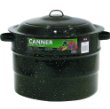My wool jersey has come out splotchy brown and black
My wool jersey has come out splotchy brown and black
Name: Lucy
—ADVERTISEMENTS—
Enameled canning pots make good dyeing kettles

Granite Ware 21-1/2-Quart Steel/Porcelain Canner
Country or region: California
Message: Hi,
My wool jersey, dyed with Jacquard acid dye at 185 F, has come out splotchy brown and black. Not heathered. Great areas of dark brown with black splotches. I'm going for black. Should I try a different dye or what? I washed with synthrapol before and after btw. Heat for 2 hrs, 185 for 35 minutes. Do not trust the acid dye enough to use again.
It's very possible that you simply did not use enough of the black dye. No matter what you're dyeing, or what type of dye you're using, it takes more dye to get a dark black than to get any other color. Using too little black will produce an off color, such as brown, purple, or dark green, depending on which dye you use.
Since your color is uneven, though, a more likely problem is that, unknowingly, you did not start with a perfectly clean garment. On garments that have been used, very often there are invisible stains that will repel dye, resulting in lighter splotches here and there. Even clean, new garments can show this problem, if the chemicals used in the manufacturing process were applied unevenly. If the stains are invisible, there's no way to tell that they are there until it's too late, and washing with Synthrapol, although helpful, does not always remove everything.
If you don't use a large enough cooking pot, you will always get uneven colors like this. If the sweater cannot move freely and easily in the pot of water plus dye, then some sections will not get as much dye as others, so they will end up a lighter color. It is often necessary to stir frequently when dyeing, to prevent some sections from failing to get their share of the dye (though you must beware of felting caused by excessive agitation). How big was the pot you used to do your dyeing in? I would not use a pot smaller than two or three gallons, minimum, for a large sweater.
When dyers want to produce uneven, variegated colors, they place a garment into a small container, too small to allow the garment to move freely, and add the dye to it without stirring. This is the basis of the method of multi-color dyeing known as low water immersion dyeing. Perhaps you inadvertently did the same thing.
The best garments to dye are those sold specifically for dyeing, with a label that prominently says PFD (for Prepared For Dyeing) or RTD (for Ready To Dye). Most commercial garments can be redyed safely, but you have to expect a certain failure rate, if the garment was not sold specifically for dyeing. Always prewash anything you want to dye (as you did), using the hottest water the garment can tolerate. After dyeing, let the wool cool in the dyebath, before rinsing it out.
You will probably do fine with the same dye again, if you use a larger pot, more water, and at least twice as much dye, and be careful to stir. Don't forget the vinegar, as your source of acid. However, if you'd like to try another dye, the very best black dye for wool is Lanaset Jet Black. See "Lanaset Dyes: A Range of Reactive and Acid Dyes for Protein Fibers". You will probably have to use mail-order to buy these dyes. There are several different companies from which you can order them, including PRO Chemical & Dye, Paradise Fibers, and Earth Guild. You will also need to buy a product called Albegal SET, to help the dye to make a smooth, solid color. Read the manufacturer's instructions before you place your order, to make sure that you get all of the ingredients that you will need. (See "Immersion Dyeing using Sabraset/Lanaset Dyes".)
If your dyeing pot is too small, the most inexpensive alternative is an enameled steel canning pot. You can buy a 21-quart enameled steel canning pot for about $20 from Amazon, though I'd encourage you to buy locally if you have a good source. Stainless steel cooking pots last longer, since they do not chip, but they are considerably more expensive. Don't buy a pot made of reactive metal, such as aluminum, for use in dyeing.
(Please help support this web site. Thank you.)
(Please help support this web site. Thank you.)
Posted: Tuesday - February 22, 2011 at 08:45 AM
Follow this blog on twitter here.
Quick Links
- All About Dyes & Dyeing Top -
- Top of this blog -
- FAQ -
- The Dye Forum -
- How to Tie Dye - How to Batik -
- Books - Toys - Plants -
- Top of this blog -
- FAQ -
- The Dye Forum -
- How to Tie Dye - How to Batik -
- Books - Toys - Plants -
More in this category:
- -
Statistics
Total entries in this blog:
Total entries in this category:
Published On: Aug 29, 2012 02:49 PM
Total entries in this category:
Published On: Aug 29, 2012 02:49 PM